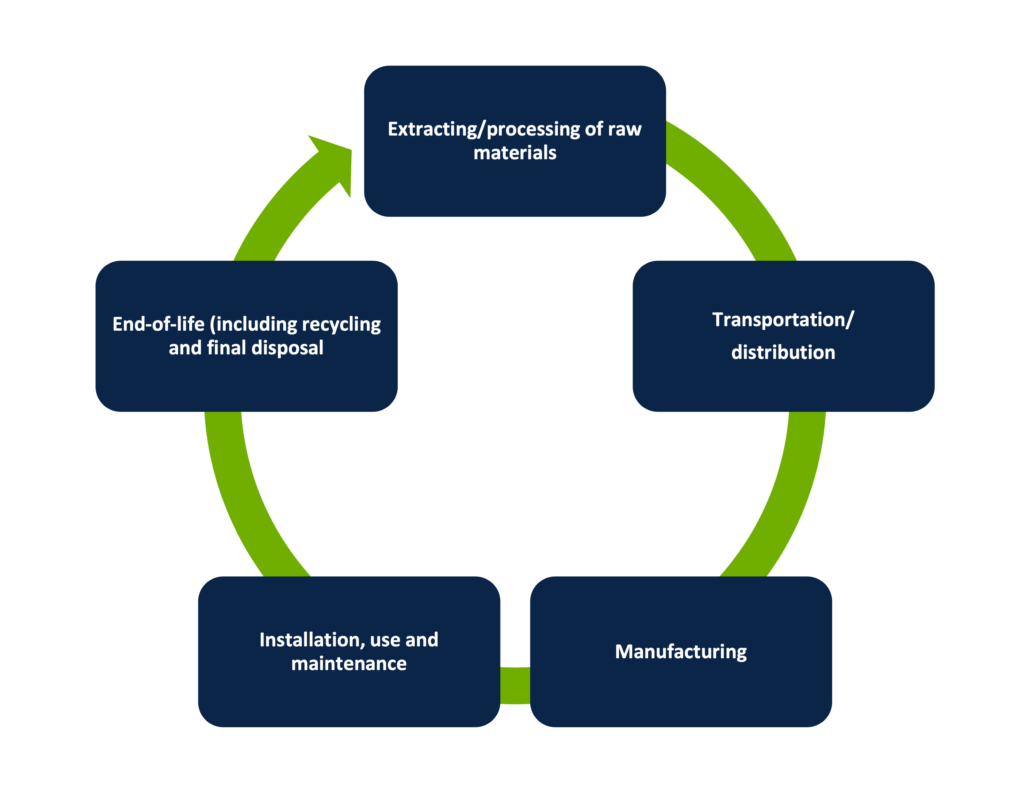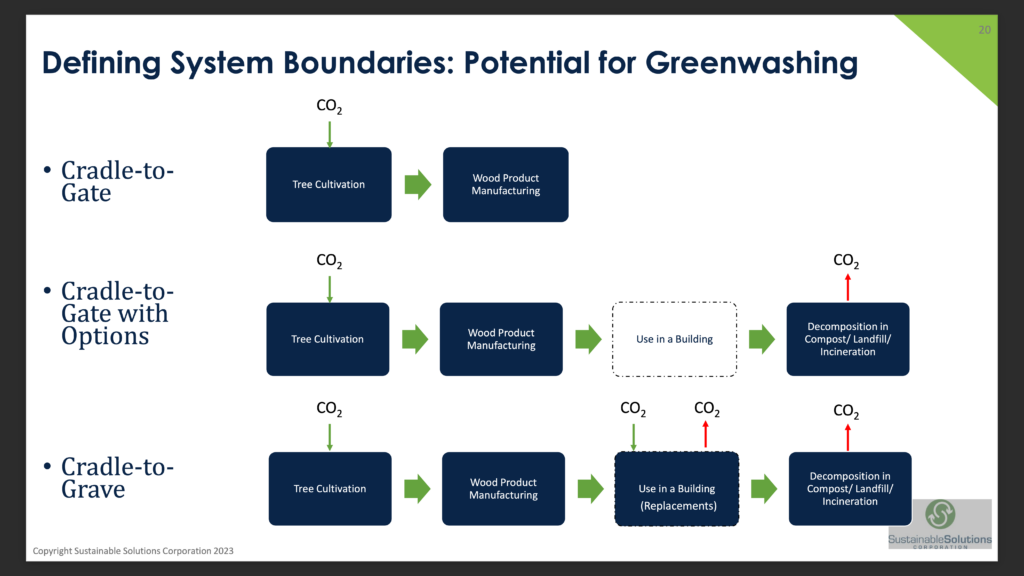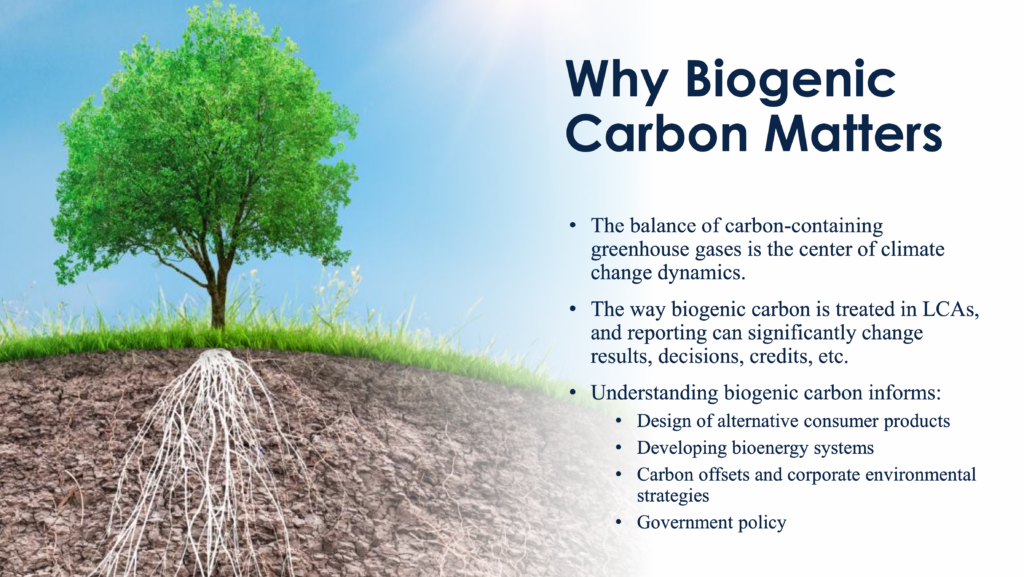On Tuesday, March 14, 2023, the Steel Framing Industry Association (SFIA) hosted an important sustainability presentation at its 2023 Annual Meeting held at Horseshoe Las Vegas in conjunction with Build23: AWCI’s Convention + Expo, in Las Vegas.
The presentation, “Green Building or Green Washing? An Unvarnished Appraisal of Wood and Steel Framing,” during the SFIA General Session at Horseshoe Las Vegas, was a “must-see” event, according to Larry Williams, SFIA executive director.

Nicole Meyer and Jonathan Provo of SSC spoke at the SFIA 2023 Annual Meeting in Las Vegas.
Nicole Meyer and Jonathan Provo of Sustainable Solutions Corporation presented a balanced, third-party assessment of the sustainability credentials of cold-formed steel (CFS) framing, dimensional lumber and cross-laminated timber. The assessment serves as a roadmap to help SFIA members navigate through the tangled web of rating systems, green building jargon and greenwashing prevalent in the construction industry.
Meyer and Provo provided an overview of life cycle assessment methodology, the role of LCA in environmental marketing claims and the inherent limitations of LCA studies. The two presenters noted that life cycle assessment, or LCA, is a key idea in all sustainability conversations.
“Life cycle thinking is fundamental to tackling how we see the sustainability attributes of products and how we interpret them,” said Provo, in an interview prior to the event. “It gives us the ability to evaluate the environmental impacts of products in a functional way — to look at buildings in their context and within system boundaries.”
Life Cycle Assessment
Meyer and Provo discussed how LCA is applied in the cold-formed steel (CFS) framing, dimensional lumber, and cross-laminated timber industries.
“Life Cycle Assessment … is a method for identifying the environmental impacts of a product, process or activity over its life cycle,” one presentation slide noted.

For simplicity, cradle-to-grave assessments of a building product involve 5 life cycle stages, though more detailed life cycle stage breakdowns can be made. (Courtesy: SSC)
LCA evaluates the environmental impacts over the entire life cycle of a product. Cradle-to-grave life cycle stages will include:
- Extracting and processing of raw materials
- Transportation and distribution
- Manufacturing
- Installation, use, and maintenance
- End-of-life: including recycling and final disposal
A cradle-to-gate LCA includes the first 3 stages of raw materials extraction and processing, transportation and manufacturing.
Meyer and Provo noted that LCA is defined currently by two core International Standards Organization standards — ISO 14040 and ISO 14044. But many LCA standards are relevant to the construction and building sector, and they include ISO 14025, ISO 21930 and EN 15804. These additional standards further define the life cycle stages and the boundaries of LCA.
When products are assessed as part of an environmental product declaration, the Product Category Rule often sets the scope of the system boundaries.

System boundaries are defined by Product Category Rules. Many PCRs stop at cradle-to-gate due to variability in applications and use, which leads to incomparable results among studies. (Courtesy: SSC)
Some PCRs limit the boundary to just cradle-to-gate or cradle-to-gate with options. Other PCRs are more rigid and require cradle-to-grave system boundaries. The variation in PCRs prevents a full understanding of the life and application of products applied in the building sector, and results cannot be compared.
“Not all LCAs are created the same,” said Meyer. “It is essential to understand the scope of the study and how those considerations can impact the carbon footprint values presented.”
Biogenic Carbon
Another important sustainability concept is biogenic carbon. Biogenic carbon is carbon absorbed from the atmosphere during biomass growth. It may be released back to the atmosphere later due to biodegradation.
“The balance of carbon-containing greenhouse gasses is the center of climate change dynamics,” one slide said. “The way biogenic carbon is treated in LCAs, and reporting, can significantly change results, decisions, credits.”

The way biogenic carbon is treated in LCAs can significantly change results. (Courtesy: SSC)
“The consideration of biogenic carbon is an evolving science,” Meyer said before the presentation. “The LCA community and the organizations responsible for development and maintenance of LCA standards are working to create consensus on the best approach for biogenic carbon allocation. Currently, best practice is to report biogenic carbon impacts separately.”
Circularity
Another key sustainability concept is circularity. This involves assessing the ability of a building material, such as steel, to be reused at the end of its life and recycled or upcycled into a new product of equal or greater value.
“The circularity of steel gives it a strong position on sustainability,” Meyer said, “since its life cycle impacts are reduced compared to virgin steel.”
“There are important product attributes one can consider during the use phase of a product’s life cycle,” Meyer added. “For example, steel framing does not require additional inputs to maintain its resiliency and structural integrity as with some alternative materials, meaning the product presents a more viable solution for recycling and reuse.”
Sustainability Learnings
Interpreting Some Wood Industry Claims
Wood industry claims identified during the analysis include:
“Using a material such as CLT [cross-laminated timber] offers carbon benefits through the sequestered carbon throughout the lifetime of the timber and unlike concrete and steel, is a regenerative material.”*
However, this claim assumes:
- The wood used to manufacture CLT comes from sustainable forestry
- The CLT never degrades during its life
Here is another wood industry claim:
“CLT has a lower embodied energy per weight than many other building materials and ‘negative’ carbon footprint, a benefit to the individual and community as a whole.”**
Again, the claim assumes:
- The end-of-life scenario for CLT is landfill
- The wood never decomposes over time in the landfill
End of Life Scenarios
Due to chemicals in treated lumber, incineration and upcycling are not usually viable end-of-life options for mass timber.
According to the EPA and a Oregon State University and University of Oregon collaborative post, the main disposal method for most wood products is a landfill. Steel products, in contrast, are usually recycled.

Most wood construction products, sources say, end up in a landfill at the end of their lives, whereas most steel products are recycled and reused. (Courtesy: SSC)
“With this education, we can start having better conversations about how to attack the subject of sustainability,” said Adam Shoemaker, ClarkDietrich corporate sustainability manager.
“We have experts to break it down for us and how it applies to our industry, and now, we can have great conversations at future SFIA meetings,” Shoemaker said. “Everybody gets the bigger picture, and we’re not spending as much time trying to educate as we are trying to solve problems.”
“Green Building or Green Washing? An Unvarnished Appraisal of Wood and Steel Framing” — An SFIA-sponsored presentation
Nicole Meyer, LCACP, LEED Green Associate
Nicole Meyer is a senior account manager at Sustainable Solutions Corporation. She is a Life Cycle Assessment (LCA) Certified Professional with experience in international standards for life cycle assessment, environmental product declarations, product category rules, and product stewardship. Since joining the team, Nicole has worked with organizations across a diverse range of industry sectors supporting environmental stewardship and corporate sustainability programs.Nicole graduated from the University of Chapel Hill in North Carolina with a Bachelor of Science in Environmental Science and received a Master of Science degree in Sustainable Engineering, with a focus in Materials Science, from Villanova University.
Jonathan Provo
Jonathan Provo is a senior project manager at Sustainable Solutions Corporation. He has experience working in product and corporate sustainability conducting Life Cycle Assessments for the metal, automotive, consumer goods and chemical industries.Jonathan received a Bachelor of Science degree in Engineering with a concentration in Chemistry from Olin College of Engineering.
About SSC
Sustainable Solutions Corporation (SSC) was founded in 2001 on the simple belief that organizations could run their businesses better—for the planet, for their bottom line, and for the communities they serve. SSC has more than two decades of experience in the development of fact-based environmental impact and sustainability studies used by companies throughout the construction supply chain to assess, optimize and capitalize on sustainable product innovation programs. Leveraging years of applied experience and industry leading expertise, SSC acts as a trusted advisor to revolutionize business operations through sustainability.
* Greengage
** CLT Sustainability
Additional Resources
- SFIA Launches Steel Framing Learning Portal
- Again, Who Says It Is More Sustainable to Build With Wood Than Steel?
- SFIA Releases Industry Environmental Products Declaration for Cold-Formed Steel Framing


